Maritime Governance Analysis for Domestic Ferry Safety and Sustainability by Employing Principles, Criteria and Indicators (PCIs) Framework
Abstract
1. Introduction
- (1)
- How can the PCI-based governance framework be formulated and applied to improve safety and sustainability in the domestic ferry industry?
- (2)
- To what extent can the PCI framework assess the adequacy of governance structures and operational practices in tackling safety and sustainability challenges specific to the domestic ferry industry?
2. Literature Review
3. Methodology
3.1. PCI Framework Development and Rationale
3.2. Literature Review and Content Analysis
3.3. Data Collection and Survey Scope
3.4. Ethical Considerations
3.5. Development of Governance Principles
- Principle 1 involves criteria like voyage planning and risk assessment, with 13 indicators assessing emergency preparedness and sustainability integration.
- Principle 2 includes governance policies and communication standards, with 13 indicators supporting policy compliance and public accountability.
- Principle 3 spans quality management, crew welfare, and training, aligned with STCW standards, with 15 indicators.
- Principle 4 focuses on climate risk, emissions reduction, and eco-operations, evaluated through 10 indicators.
3.6. Participatory Validation and Practical Application
3.7. Indicator Weighing and Scoring Mechanisms
3.8. Statistical Validation
3.9. Integration of Governance Models and Risk-Based Approaches
4. Results
4.1. Principle 1—Proactive Planning for Safe Operations
4.2. Principle 2—Governance with Safety-Centric Approach
4.3. Principle 3—Effective Management and Monitoring
4.4. Principle 4—Climate-Resilient Safety Practices
4.5. Cross—Principle Insights
5. Discussion
5.1. Principle 1—Ensure Proactive Planning for Safe Operations
5.1.1. Voyage Planning
Current Findings
Future Implications
Statistical Analysis
5.1.2. Risk Management
Current Findings
Future Implications
Statistical Analysis
5.1.3. Emergency Preparedness
Current Findings
Future Implications
Statistical Analysis
5.1.4. Incident Response
Current Findings
Future Implications
Statistical Analysis
5.2. Principle 2—Vibrant Governance Policies with Safety-Centric Approach
5.2.1. Transparency and Accountability
Current Findings
Future Implications
Statistical Analysis
5.2.2. Governing Policy and Legal Instruments
Current Findings
Future Implications
Statistical Analysis
5.2.3. Communication and Coordination
Current Findings
Future Implications
Statistical Analysis
5.2.4. Stakeholder Engagement
Current Findings
Future Implications
Statistical Analysis
5.3. Principle 3—Encourage Effective Management and Monitoring
5.3.1. Quality Management Systems
Current Findings
Future Implications
Statistical Analysis
5.3.2. Employee and Passenger Well-Being
Current Findings
Future Implications
Statistical Analysis
5.3.3. Crew Training and Competence
Current Findings
Future Implications
Statistical Analysis
5.3.4. Community Impact
Current Findings
Future Implications
Statistical Analysis
5.4. Principle 4—Promote Climate-Resilient Safety Practices
5.4.1. Climate Risk Assessments
Current Findings
Future Implications
Statistical Analysis
5.4.2. Policy Development
Current Findings
Future Implications
Statistical Analysis
5.4.3. Sustainable Solutions
Current Findings
Future Implications
Statistical Analysis
6. Governance Model and PCI Framework Integration in Maritime Safety
7. Key Recommendations
- a.
- Improve Policy Coherence—Align national regulations with international frameworks (IMO, ISO, ESG). This foundational step is broadly achievable and provides consistency across governance and safety practices.
- b.
- Promote Stakeholder Collaboration—Foster cooperation among operators, regulators, passengers, and local communities. Such collaboration builds trust, raises awareness, and supports collective problem-solving with limited financial demands.
- c.
- Integrate Advanced Technologies—Introduce real-time analytics, predictive modeling, and renewable energy solutions. Phased or pooled implementation can make adoption more viable for smaller operators.
- d.
- Focus on ESG Integration—Institutionalize ESG considerations within operational policies and encourage knowledge-sharing across operators. This promotes long-term sustainability and scalability in line with resource availability.
- e.
- Improve Safety Training and Drills—Strengthen crew training on climate adaptation, emergency response, and advanced technologies. Programs can be adapted regionally depending on infrastructure and training capacity.
- f.
- Address Governance and Policy Gaps—Establish regular reviews of governance structures to improve accountability, transparency, and rights-based policies. This ensures continuous adaptation to evolving safety and environmental requirements.
8. Conclusions
Author Contributions
Funding
Institutional Review Board Statement
Informed Consent Statement
Data Availability Statement
Conflicts of Interest
Abbreviations
| AHP | Analytic hierarchy process |
| ASEAN | Association of South-East Asian Nations |
| ESG | Environmental social governance |
| IMO | International Maritime Organization |
| ISO | International Organization for Standardization |
| ISM | International safety management |
| MCDA | Multi-criteria decision analysis |
| OECD | The Organization for Economic Cooperation and Development |
| PCI | Principle, criteria and indicator |
| PRI | Principles of responsible investment |
| SASB | Sustainability Accounting Standards Board |
| STSs | Socio-technical systems |
| SMART | Simple multi-attribute rating technique |
| SRM | Standardized Reporting Mechanisms |
| STCW | Standards of training certification and watchkeeping for seafarers |
| TCFD | Task Force on Climate-related Financial Disclosures |
References
- ESCAP. Study on the Improvement of Maritime Transport Safety in the Escap Region. Available online: https://www.unescap.org/sites/default/files/Report%20on%20Improving%20Maritime%20Transport%20Safety%20in%20the%20ESCAP%20region%20(FNL)_19%20July%202017_0.pdf (accessed on 21 January 2023).
- Kirillova, Y.V.; Meleshenko, Y.S. Justification of Financial Safety Analysis Approach in Cargo-and-Passenger Ferry Operations Management. Transp. Telecommun. 2014, 15, 111–119. [Google Scholar] [CrossRef]
- Oxford Economics. Economic Impact of Global Ferry Industry, London. 2021. Available online: https://www.oxfordeconomics.com/resource/economic-impact-of-the-global-ferry-industry/ (accessed on 16 February 2025).
- Baig, M.Z.; Lagdami, K.; Mejia, M.Q. Safeguarding Maritime Transport: Disclosing the Paradox of Safety in Domestic Ferry Operations. Aust. J. Marit. Ocean Aff. 2024, 17, 496–525. [Google Scholar] [CrossRef]
- Hebbar, A.; Yildiz, S.; Kahlouche, N.; Schröder-Hinrichs, J.-U. Safety of Domestic Ferries: A Scoping Study of Seven High-Risk Countries; World Maritime University: Malmö, Sweden, 2023. [Google Scholar]
- Chae, C.; Kim, K.H.; Kang, S.Y. Limiting Ship Accidents by Identifying Their Causes and Determining Barriers to Application of Preventive Measures. J. Mar. Sci. Eng. 2021, 9, 302. [Google Scholar] [CrossRef]
- Roe, M. Maritime Governance and Policy-Making: The Need for Process Rather than Form. Asian J. Shipp. Logist. 2013, 29, 167–186. [Google Scholar] [CrossRef]
- Schröder-Hinrichs, J.-U.; Baldauf, M.; Hollnagel, E. From Titanic to Costa Concordia-a Century of Lessons Not Learned. WMU J. Marit. Aff. 2012, 11, 151–167. [Google Scholar] [CrossRef]
- Baird, N. Fatal Ferry Accidents, Their Causes and How to Prevent Them; University of Wollongong: Wollongong, Australia, 2018. [Google Scholar]
- ESCAP. Study on Strengthening Capacity to Plan and Develop Efficient Coastal Shipping in Southeast Asia; ESCAP: Bangkok, Thailand, 2018. [Google Scholar]
- Bowman, R.; Smythe, T. Conceptualizing Maritime Governance. Coast Guard J. Saf. Secur. Sea 2019, 76, 6–11. [Google Scholar]
- Schröder-Hinrichs, J.-U.; Praetorius, G.; Graziano, A.; Kataria, A.; Baldauf, M. Introducing the Concept of Resilience into Maritime Safety. In Proceedings of the 6th Resilience Engineering Association’s International Symposium, Lisbon, Portugal, 22–25 June 2015; Resilience Engineering Association: Lisbon, Portugal, 2015; pp. 176–182. [Google Scholar]
- IMO. Resolution MSC.518(105)—Model Regulations on Domestic Ferry Safety; IMO: London, UK, 2022. [Google Scholar]
- IMO. IMO Revised Guidelines on the Implementation of the International Safety Management (ISM) Code by Administration; IMO: London, UK, 2018; Volume 1118. [Google Scholar]
- OECD. ESG Investing and Climate Transition—Market Practices, Issues and Policy Considerations; OECD: Paris, France, 2021. [Google Scholar]
- World Bank. The Global Compact Who Cares Wins: Connecting Financial Markets to a Changing World; World Bank: Washington, DC, USA, 2004. [Google Scholar]
- UNCTAD. Review of Maritime Transport 2023—Towards a Green and Just Transition; United Nations Conference on Trade and Development: New Jersey, NY, USA, 2023. [Google Scholar]
- Nascimento, J.; Edith, N. Integrating ESG in the Blue Economy and Emerging Risks in Maritime Transport. Available online: https://acginter.com/en/integrating-esg-in-the-blue-economy-and-emerging-risks-in-maritime-transport/ (accessed on 18 February 2025).
- Li, T.T.; Wang, K.; Sueyoshi, T.; Wang, D.D. ESG: Research Progress and Future Prospects. Sustainability 2021, 13, 11663. [Google Scholar] [CrossRef]
- Kalleklev, Ø. Environmental, Social and Governance Report; Flex LNG Ltd.: Oslo, Norway, 2019; Available online: https://www.flexlng.com/wp-content/uploads/2019/11/ESG-Report_Flex-LNG.pdf (accessed on 18 October 2024).
- Hollnagel, E. Safety–I and Safety–II: The Past and Future of Safety Management, 1st ed.; Ashgate Publishing Company: Surrey, UK, 2014; ISBN 978-1-4724-2305-4. [Google Scholar]
- OECD. Guidance on Developing Safety Performance Indicators Related to Chemical Accident Prevention Preparedness and Response for Industry; OECD: Paris, France, 2008. [Google Scholar]
- Goulielmos, A.M.; Goulielmos, M.A.; Gatzoli, A. The Accident of Passenger-Car Vessel Samina Express (2000), When 80 Persons Died—An Analysis by the Principles of Nonlinear Management. Dis. Prev. Manag. 2000, 18, 21. [Google Scholar] [CrossRef]
- Kim, T.; Nazir, S.; Øvergård, K.I. A STAMP-Based Causal Analysis of the Korean Sewol Ferry Accident. Saf. Sci. 2016, 83, 93–101. [Google Scholar] [CrossRef]
- Papanikolaou, A.; Spanos, D.; Boulougouris, E.; Eliopoulou, E.; Alissafaki, A. Investigation into the Sinking of the Ro-Ro Passenger Ferry Express Samina. Int. Shipbuild. Prog. 2004, 51, 26. [Google Scholar]
- Rothe, D.; Muzzatti, S.; Mullins, C.W. Crime on the High Seas: Crimes of Globalization and the Sinking of the Senegalese Ferry Le Joola. Crit. Criminol. 2006, 14, 159–180. [Google Scholar] [CrossRef]
- Kim, J.; Lee, G.; Kim, H. Analysis of Operational Efficiency Considering Safety Factors as an Undesirable Output for Coastal Ferry Operators in Korea. J. Mar. Sci. Eng. 2020, 8, 367. [Google Scholar] [CrossRef]
- Hong, J.P.; Kim, Y.; Shim, H.; Kang, H.; Kim, Y.; Kim, G.B.; Cho, S. Study on a Fully Electrified Car Ferry Design Powered by Removable Battery Systems Considering Domestic Coastal Environment. J. Ocean Eng. Technol. 2021, 35, 1–12. [Google Scholar] [CrossRef]
- Wang, H.; Boulougouris, E.; Theotokatos, G.; Priftis, A.; Shi, G.; Dahle, M.; Tolo, E. Risk Assessment of a Battery-Powered High-Speed Ferry Using Formal Safety Assessment. Safety 2020, 6, 39. [Google Scholar] [CrossRef]
- Pillay, M. Accident Causation, Prevention and Safety Management: A Review of the State-of-the-Art. Procedia Manuf. 2015, 3, 1838–1845. [Google Scholar] [CrossRef]
- Huang, S.T.; Bulut, E.; Duru, O. Service Quality Assessment in Liner Shipping Industry: An Empirical Study on Asian Shipping Case. Int. J. Shipp. Transp. Logist. 2015, 7, 221–242. [Google Scholar] [CrossRef]
- Karakasnaki, M.; Vlachopoulos, P.; Pantouvakis, A.; Bouranta, N. ISM Code Implementation: An Investigaation of Safety Issues in the Shipping Industry. WMU J. Marit. Aff. 2018, 17, 461–474. [Google Scholar] [CrossRef]
- Baten, A.S.M.A. A Stronger Safety Regime Is Vital to Ensure Safer Passengers’ Movement at Inland Water Transportation Sector of Riverine-Bangladesh. BIMRAD J. 2022, 3, 38–55. [Google Scholar]
- Ha, K.-M. A Lesson Learned from the Ferry Sewol Sinking in South Korea in 2014. Int. J. Emerg. Manag. 2017, 13, 210–215. [Google Scholar] [CrossRef]
- Aisha, N. Maritime Safety on Lake Victoria—Analysis of the Legal and Regulatory Framework. Master’s Thesis, University of Oslo, Oslo, Norway, 11 January 2011. [Google Scholar]
- Fu, G. An Application of 24 Model to Analyse Capsizing of the Eastern Star Ferry. Polish Marit. Res. 2017, 24, 116–122. [Google Scholar] [CrossRef]
- Batalden, B.; Sydnes, A.K. Maritime Safety and the ISM Code: A Study of Investigated Casualties and Incidents. WMU J. Marit. Aff. 2014, 1980, 3–25. [Google Scholar] [CrossRef]
- Yanning, J. An Application of AcciMap to Identify and Analyse the Causes of the Eastern Star and Sewol Casualties. Master’s Thesis, World Maritime University, Malmö, Sweden, 2016. [Google Scholar]
- Wang, X.; Zhang, B.; Zhao, X.; Wang, L.; Tong, R. Exploring the Underlying Causes of Chinese Eastern Star, Korean Sewol, and Thai Phoenix Ferry Accidents by Employing the HFACS-MA. Int. J. Environ. Res. Public Health 2020, 17, 4114. [Google Scholar] [CrossRef]
- Baig, M.Z.; Iqbal, K.M.J.; Lagdami, K.; Mejia, M.Q. Maritime Governance Analysis for Safety and Environmental Aspects of Domestic Ferries: A’WOT of a Developing Country. J. Territ. Marit. Stud. 2024, 11, 65–86. [Google Scholar] [CrossRef]
- Lee, J.Y.; Kim, S.Y.; Kim, J.M.; Shin, I.S.; Kim, S.W. When a Maritime Disaster Disrupts the Community: The Longitudinal Course of Post-Traumatic Stress Disorder and Predicted Factors after Sewol Ferry Disaster in South Korea. J. Affect. Disord. 2021, 278, 637–642. [Google Scholar] [CrossRef]
- Baig, M.Z.; Lagdami, K.; Mejia, M.Q.J. Enhancing Maritime Safety: A Comprehensive Review of Challenges and Opportunities in the Domestic Ferry Sector. Marit. Technol. Res. 2024, 6, 1–28. [Google Scholar] [CrossRef]
- Roe, M. Maritime Governance Speed, Flow, Form, Process; Springer International Publishing: London, UK, 2016; ISBN 9783319217468. [Google Scholar]
- Reason, J. The Contribution of Latent Human Failures to the Breakdown of Complex Systems. Philos. Trans. R. Soc. Lond. B. Biol. Sci. 1990, 327, 475–484. [Google Scholar] [CrossRef] [PubMed]
- Rasmussen, J. Risk Management in a Dynamic Society: A Modelling Problem. Saf. Sci. 1997, 27, 183–213. [Google Scholar] [CrossRef]
- Hollnagel, E. Synesis: The Unification of Productivity, Quality, Safety and Reliability; Routledge: London, UK, 2020. [Google Scholar] [CrossRef]
- Leveson, N.G. Engineering a Safer World Systems Thinking Applied to Safety; Moses, J., de Neufville, R., Heitor, M., Morgan, G., Paté-Cornell, E., Rouse, W., Eds.; The MIT Press: London, UK, 2011; ISBN 9780333227794. [Google Scholar]
- Dekker, S. Just Culture: Balancing Safety and Accountability, 2nd ed.; Dekker, S., Ed.; Taylor & Francis Group: New York, NY, USA, 2012; ISBN 9781119130536. [Google Scholar]
- ACI. Safety Management Systems Handbook, 1st ed.; ACI World Safety and Technical Standing Committee: Montreal, QC, Canada, 2016; ISBN 9781927907429. [Google Scholar]
- Hollnagel, E. The Changing Nature of Task Analysis. In Handbook of Human Factors and Ergonomics; Salvendy, G., Karwowski, W., Eds.; John Wiley & Sons Ltd.: Hoboken, NJ, USA, 2021; p. 10. [Google Scholar]
- Yan, Z.; Zhou, Z.; Du, K. How Does Environmental Regulatory Stringency Affect Energy Consumption? Evidence from Chinese Firms. Energy Econ. 2023, 118, 14. [Google Scholar] [CrossRef]
- ECLAC. Transport Governance: Theoretical and Policy Perspectives. 2016. Available online: https://www.yunbaogao.cn/index/partFile/5/cepal/2022-03/5_574.pdf (accessed on 21 December 2024).
- Nguyen, N.; Bosch, O. The Art of Interconnected Thinking: Starting with the Young. Challenges 2014, 5, 239–259. [Google Scholar] [CrossRef]
- Voyer, M.; Farmery, A.K.; Kajlich, L.; Vachette, A.; Quirk, G. Assessing Policy Coherence and Coordination in the Sustainable Development of a Blue Economy. A Case Study from Timor Leste. Ocean Coast. Manag. 2020, 192, 105187. [Google Scholar] [CrossRef]
- Rashid, C.K.; Islam, M.M.R. Reasons and Remedies of Inland Passenger Vessels Accidents in Bangladesh. In Proceedings of the 1st International Conference on Mechanical Engineering and Applied Science, Dhaka, Bangladesh, 22–23 February 2017; AIP Publishing: Melville, NY, USA, 2017; Volume 1919, p. 9. [Google Scholar]
- Abdullah, S.; Razak, A.A.; Hanafi, M.H.; Jaafar, M. Implementation Barriers of ISO 9000 within the Malaysian Local Government. Int. J. Qual. Reliab. Manag. 2013, 30, 26. [Google Scholar] [CrossRef]
- ESG in the Shipping Sector: The Role of ESG in the Evaluation of Shipping Companies; Deloitte: London, UK, 2021; Available online: https://share.google/DAfPgXle1QA0Rk7JT (accessed on 10 October 2024).
- ISO 14001:2015; Environmental Management Systems—Requirements Guidance Document. DNV GL: Hovik, Norway, 2015.
- ISO 9001:2015; Quality Management Systems—Requirements Guidance Document. DNV GL: Hovik, Norway, 2015.
- Pinsky, V.C.; Isak, K. Governing REDD+ A State of the Art Review. Rev. Adm. UFSM 2019, 12, 182–197. [Google Scholar] [CrossRef]
- Abdul Wahib, S.; Abdon, N.; Hariadi, K.; Jossi, K.; Mas Achmad, S.; Myrna, S.; Purwadi, S.; Sofian, E.; Sunaryo. The 2012 Indonesia Forest, Land, and REDD+ Governance Index; Sølvberg, T., Ed.; UNDP: Jakarta, Indonesia, 2012; ISBN 9786029653960. [Google Scholar]
- Aslam, B.; Muhammad, K.; Iqbal, J.; Akhtar, N.; Mottaeva, A.B.; Fedorovna, T.T.; Barykin, S.; Khan, M.I. Coherence Analysis of National Maritime Policy of Pakistan across Shipping Sector Governance Framework in the Context of Sustainability. Sustainability 2023, 15, 7665. [Google Scholar] [CrossRef]
- Heryandri, K. The Importance of Ferry Ro-Ro Transportation in Indonesia and Its Contrary to The Lack of Attention on Ferry Ro-Ro Safety, Which Cause High Rate of Accidents and Fatalities. Adv. Transp. Logist. Res. 2018, 1, 641–651. Available online: https://proceedings.itltrisakti.ac.id/index.php/ATLR/article/view/69 (accessed on 18 January 2025).
- Nõmmela, K.; Kaare, K.K. Maritime Policy Design Framework with ESG Performance Approach: Case of Estonia. Economies 2022, 10, 88. [Google Scholar] [CrossRef]
- Todnem, B.R. Organisational Change Management: A Critical Review. J. Change Manag. 2005, 5, 369–380. [Google Scholar] [CrossRef]
- Iqbal, K.M.J.; Akhtar, N.; Amir, S.; Naseer, H.M.; Khan, M.I. Capacity Assessment of Community Based Organizations for Climate Smart Agriculture Extension to Promote Climate Compatible Development: A Governance Index Approach. Int. J. Mod. Agric. 2021, 10, 4258–4271. [Google Scholar]
- Mayring, P. Forum: Quality Social Research; Universität Klagenfurt: Klagenfurt, Austria, 2000; p. 10. [Google Scholar]
- Stemler, S.E. An Overview of Content Analysis. Peer Rev. Electron. J. 2001, 7, 11. [Google Scholar] [CrossRef]
- Carpenter, A.; Johansson, T.M.; Skinner, J.A. (Eds.) Sustainability in the Maritime Domain: Towards Ocean Governance and Beyond, 1st ed.; Springer Nature AG: Cham, Switzerland, 2021; ISBN 978-3-030-6932-4. [Google Scholar]
- Dan, A. UN Principles for Responsible Investment (PRI): Principles, Significance, and Impact. Available online: https://www.supermoney.com/encyclopedia/un-principles-for-responsible-investment-pri (accessed on 13 March 2025).
- Intercargo. ESG Review 2024. 2024. Available online: https://www.intercargo.org/wp-content/uploads/2024/04/INTERCARGO-ESG-Review-2024-1.pdf (accessed on 13 March 2025).
- Hovland, I. Successful Communication A Tool Kit for Researchers and Civil Society Organizations; Overseas Development Institute: London, UK, 2005; ISBN 0 85003 776 X. [Google Scholar]
- Höckerstedt, E. Do the SASB Standards Contribute to the Development of Sustainability Reporting? A Content Analysis of Finnish Banks’ Sustainability Reports from an Investor ’s Perspective; Åbo Akademi University: Turku, Finland, 2022. [Google Scholar]
- TCFD. Recommendations of the Task Force on Climate-Related Financial Disclosures; TCFD: Basel, Switzerland, 2017; pp. 1–74. [Google Scholar]
- UNPRI. An Introduction to Responsible Investment: Policy, Structure and Process. Principles for Responsible Investment. 2019. Available online: https://www.unpri.org/introductory-guides-to-responsible-investment/an-introduction-to-responsible-investment-policy-structure-and-process/4917.article (accessed on 14 March 2025).
- Fälth, J.; Ljungqvist, M. Identification of Leading Objective Indicators of Safety in Shipping; Lund University: Lund, Sweden, 2013. [Google Scholar]
- Teperi, A.-M.; Lappalainen, J.; Puro, V.; Perttula, P. Assessing Artefacts of Maritime Safety Culture—Current State and Prerequisites for Improvement. WMU J. Marit. Aff. 2018, 18, 79–102. [Google Scholar] [CrossRef]
- Francisco, C.; Gomes, S.; Costa, H.G.; Barros, A.P. de Sensibility Analysis of MCDA Using Prospective in Brazilian Energy Sector. J. Model. Manag. 2017, 12, 475–497. [Google Scholar] [CrossRef]
- Keeney, R.L.; Raiffa, H. Decisions with Multiple Objectives: Preferences and Value Tradeoffs; Cambridge University Press: Newyork, USA, 1993; ISBN 0-521-44185-4. [Google Scholar]
- Odu, G.O. Weighting Methods for Multi-Criteria Decision Making Technique. J. Appl. Sci. Environ. Manag. 2019, 23, 1449. [Google Scholar] [CrossRef]
- Aguinis, H.; Hill, N.S.; Bailey, J.R. Best Practices in Data Collection and Preparation: Recommendations for Reviewers, Editors, and Authors. Organ. Res. Methods 2021, 24, 678–693. [Google Scholar] [CrossRef]
- Smith, R. A Mutual Information Approach to Calculating Nonlinearity. Stat 2015, 4, 291–303. [Google Scholar] [CrossRef]
- Taherdoost, H. Validity and Reliability of the Research Instrument; How to Test the Validation of a Questionnaire/Survey in a Research. SSRN Electron. J. 2018, 9, 29–36. [Google Scholar] [CrossRef]
- Tavakol, M.; Dennick, R. Making Sense of Cronbach’s Alpha. Int. J. Med. Educ. 2011, 2, 53–55. [Google Scholar] [CrossRef] [PubMed]
- Ojha, S. Community Forestry in Nepal—An A’WOT Analysis. Master’s Thesis, Faculty of Science and Forestry, Joensuu, Finland, 2021. [Google Scholar]
- Kristiansen, S. Maritime Transportion Safety Management and Risk Analysis, 1st ed.; Elsevier Butterworth-Heinemann: Oxford, UK, 2005; ISBN 07506 59998. [Google Scholar]
- Lozano, R. Are Companies Planning Their Organisational Changes for Corporate Sustainability? An Analysis of Three Case Studies on Resistance to Change and Their Strategies to Overcome It. Corp. Soc. Responsib. Environ. Manag. 2012, 20, 21. [Google Scholar] [CrossRef]
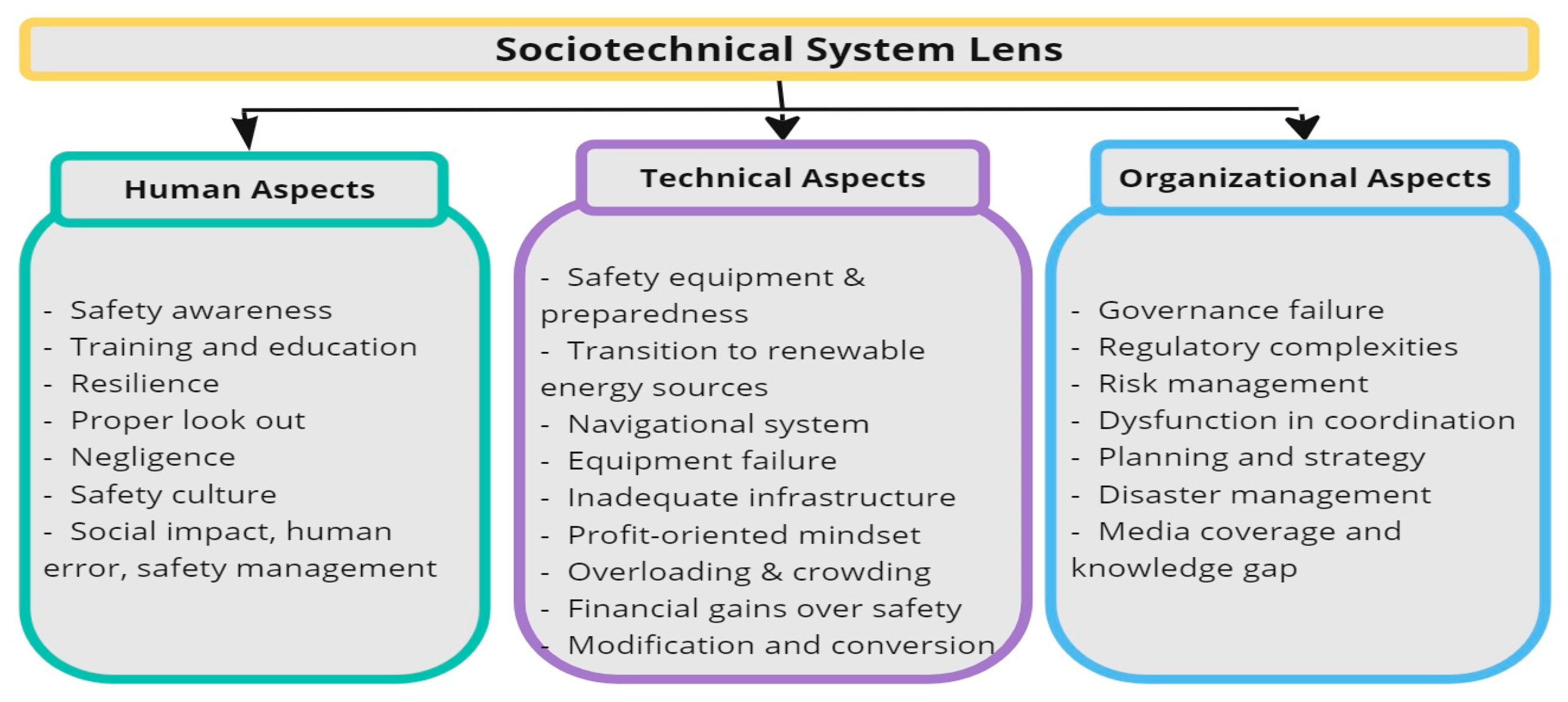
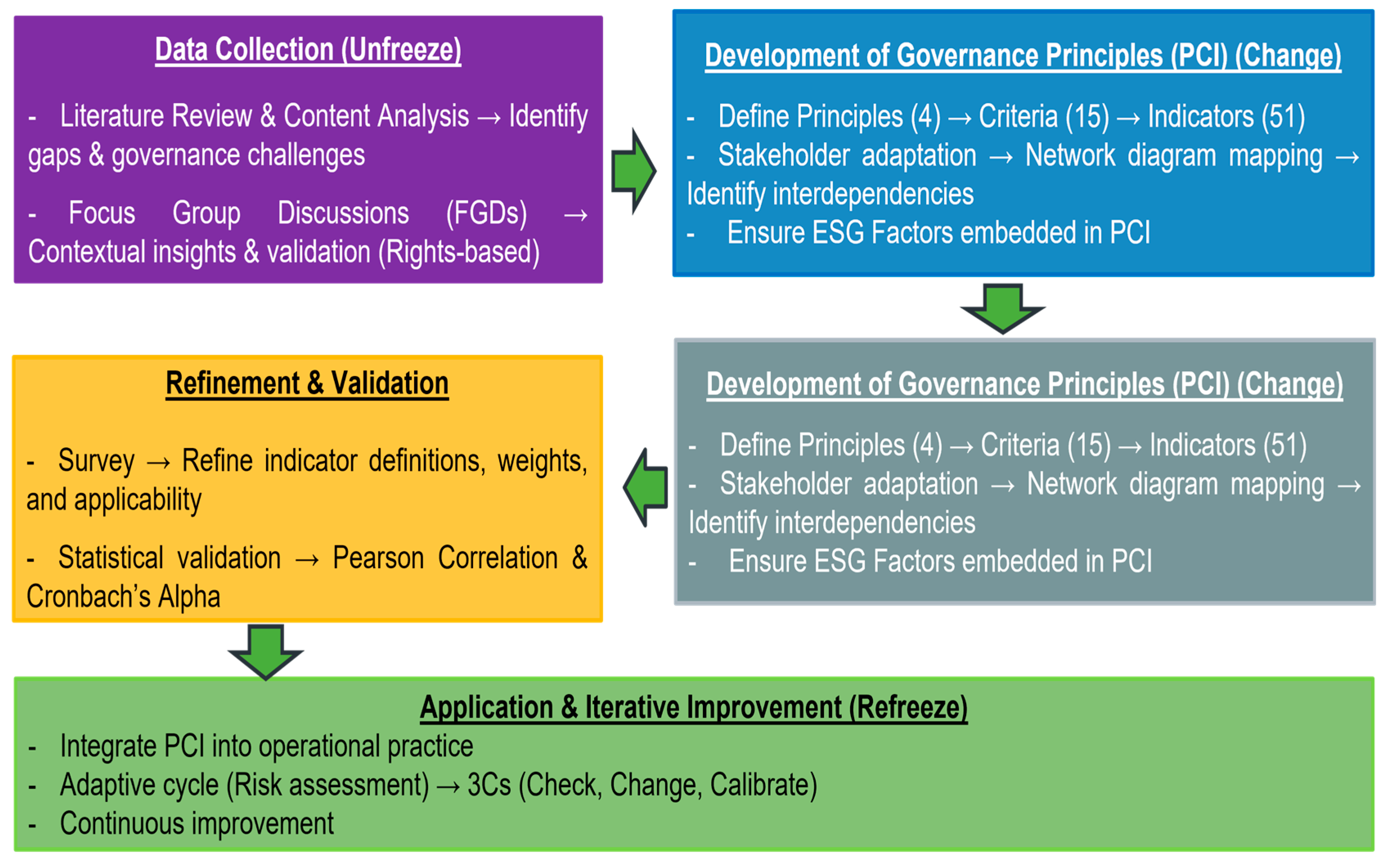
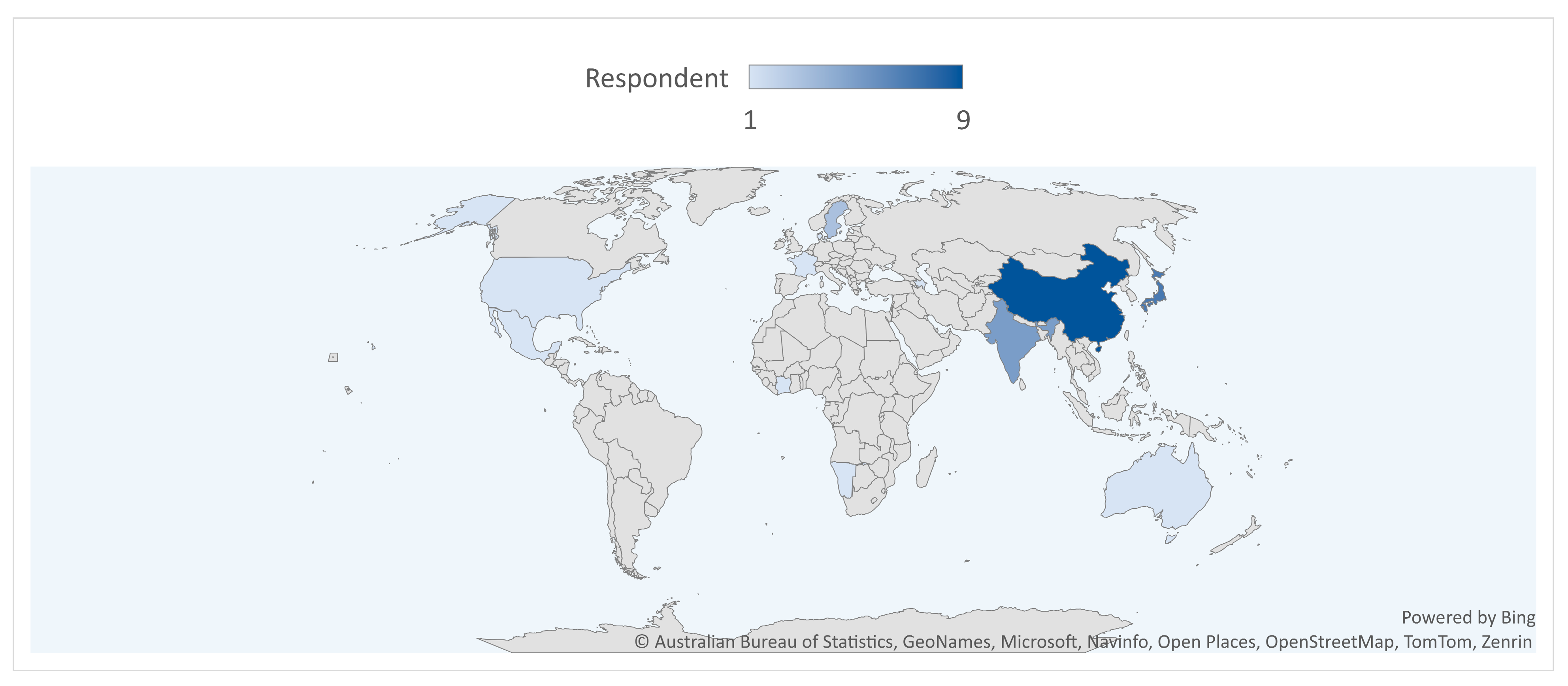

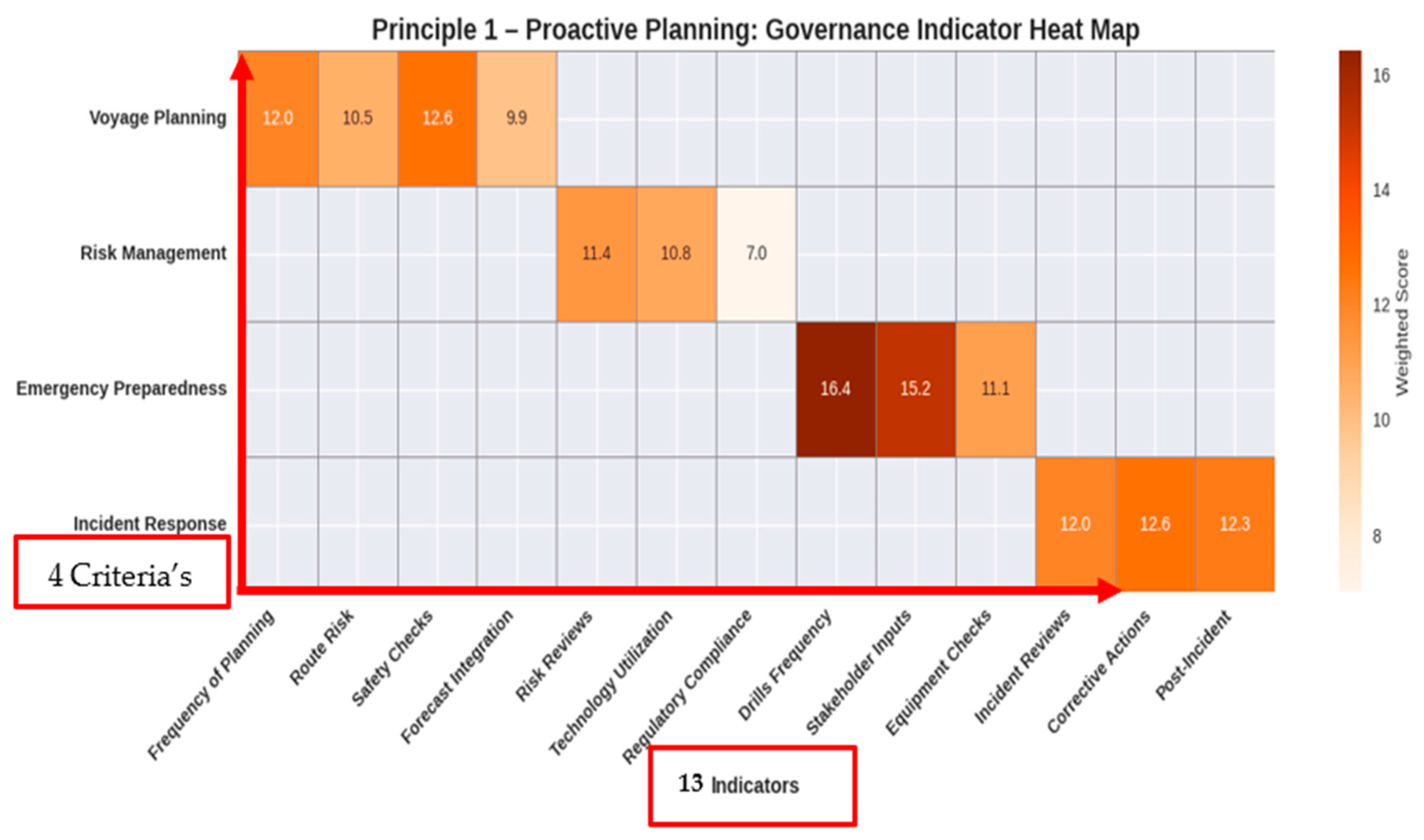
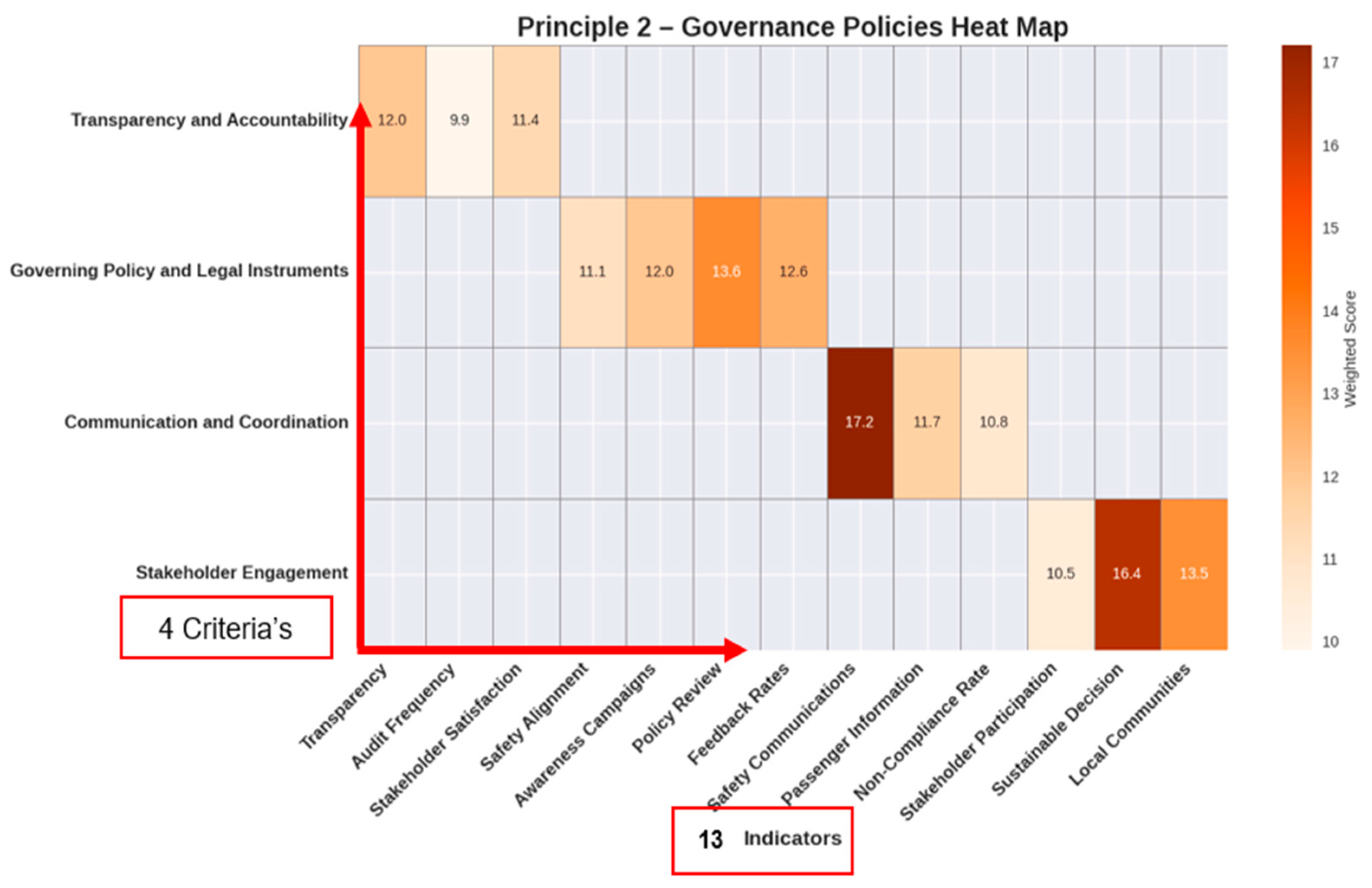
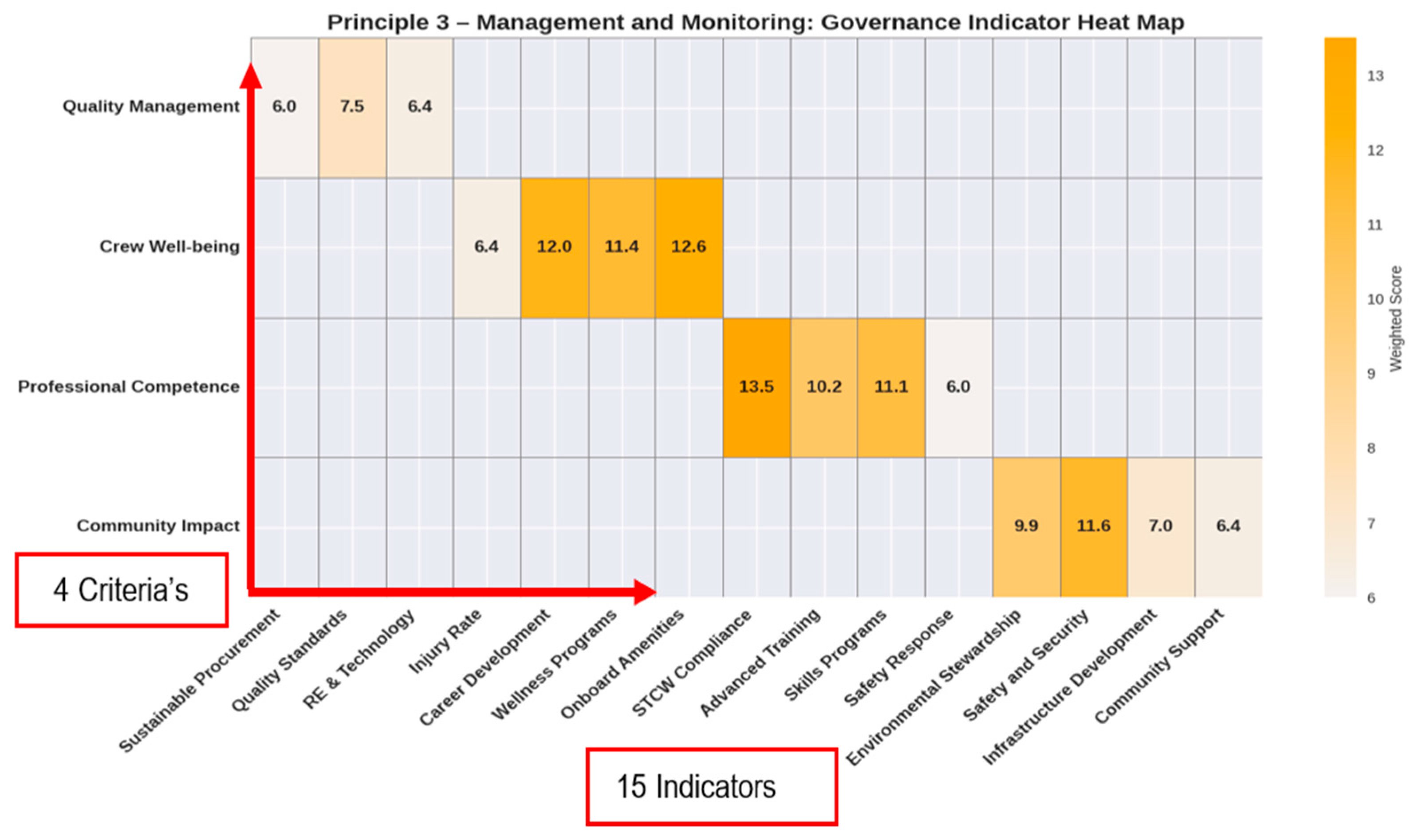


| Incident | Fatality | Findings | Recommendations | Challenges |
|---|---|---|---|---|
| Le Joola Senegal [26] | 1863 casualties | The government admitted errors; ministers resigned | Government errors; resignation of officials | Policy deficiencies; limited socio-technical integration |
| Sewol Ferry South Korea [24,34,38] | 304 deaths | -Financial incentives and cost-cutting efforts moved the vessel to an unacceptable high-risk state, causing the accident Impose constraints and establish effective feedback by regulatory agencies and industry associations Systems approach needed for detection and prevention of safety gaps Excessive ship modifications made | Underline an in-depth national disaster response framework Emphasis on balancing safety with economic, efficiency, and performance restrictions Demonstrate a lack of awareness of risk, improper actions of the captain, and the need for risk mitigation options | Inadequate disaster management Recognize policy and governance gaps |
| MV Bukoba Tanzania [9,35] | 894 fatalities | No ticketing controls Overloaded at an intermediate port Capsized without transmitting a distress call Rescue attempt failed Ship owners and crew overlooked regulations, inspection, and maintenance Officials were incompetent | Enforce regulations to avoid overloading, ticketing, and control at ports Develop a maritime safety culture Enhance rescue procedures Focus on crew qualifications, inspections, and maintenance | Poor safety culture, and legislation Identified gaps include an overloaded, negligence of safety standards and a poor maritime safety culture Inadequate crew training |
| Eastern Star China [36,39] | 442 deaths | Capsized due to foul weather Lack of safety knowledge (the captain, chief officer, and senior management) Lack of realization regarding the importance of regulation and risk | Implement a safety management system and safety culture Address deficiencies in crew knowledge in emergency handling | Need for laws and mandatory safety devices; disaster response gaps |
| MV Samina Greece [23,25] | 80 deaths | Poor navigation Insufficient safety equipment Inadequate crew information Failure in evacuation procedures Inadequate readiness of emergency power systems IMO’s ISM Code not properly implemented | Improve navigation Ensure life-saving equipment Provide proper crew support and information Enhance evacuation procedures Strengthen ISM Code implementation | Weak emergency preparedness Inadequate governance in safety training and equipment maintenance |
| Principle | Description | Rational | |
|---|---|---|---|
| 1. | Proactively plan and continuously improve safety measures, integrating voyage planning with ongoing safety developments | Emphasizes risk anticipation, operational planning, and safety readiness | 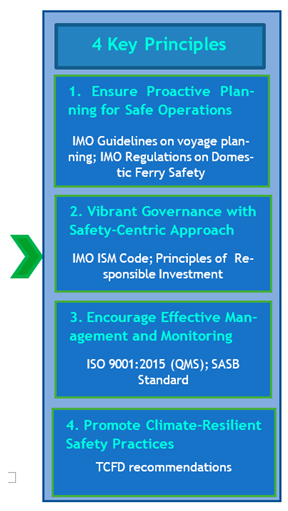 |
| 2. | Advance safety-focused governance through policy, accountability, and informed decision-making across all organizational levels | Strengthens transparency, safety accountability, and legal coherence | |
| 3. | Embed quality management, social responsibility, and stakeholder well-being to foster ethical, sustainable operations through leadership and community engagement | Promotes social responsibility, quality assurance, and performance tracking | |
| 4. | Mitigate climate-related risks through safety-driven, certified operations that enhance resilience, environmental sustainability, and reputational value | Prioritizes eco-efficiency, resilience, and emissions-related risk management |
| Level of Coherence | Rate/Scale | Percentage | Parameter |
|---|---|---|---|
| Full Compliance | 5 | 100% | Strong configuration with safety standards, optimal execution of governance principles |
| High Compliance | 4.0–4.99 | 80–99.99% | Meets most safety standards with minor areas for enhancement |
| Moderate Compliance | 3.0–3.99 | 60–79.99% | Adequate implementation but with prominent areas for improvement |
| Low Compliance | 2.0–2.99 | 40–59.99% | Noteworthy gaps in compliance; major improvements needed |
| Minimal Compliance | 1.0–1.99 | 20–39.99% | Very limited adherence to governance standards, requiring reform |
| Not Applicable | 0.1–0.99 | 1–19.99% | Indicator does not apply to existing ferry operations or governance context |
| Principle | Overall Score | Index Score Range | % Age Range | Summary |
|---|---|---|---|---|
| Principle 1 Proactive Planning | 153.8 | 3.8–4.9 (High) | 75–90% | Strong compliance in emergency preparedness and risk assessments; post-incident reviews remain inconsistent |
| Principle 2 Governance Approaches | 162.7 | 3.5–4.5 (Moderate-High) | 75–85% | Transparency and stakeholder engagement are vigorous; policy enforcement and communication clarity necessitate improvement |
| Principle 3 Effective Management & Monitoring | 138.0 | 3.0–4.2 (Moderate) | 70–85% | Crew training and wellness initiatives are strong; gaps persist in technology adoption and community engagement |
| Principle 4 Climate-Resilient Safety Practices | 142.5 | 2.9–4.1 (Moderate) | 65–75% | Effective climate risk assessments; policy updates and stakeholder participation require reinforcement |
| Criteria’s | Weighted Score | Compliance Level | Summary |
|---|---|---|---|
| Voyage Planning | 45.0 | High | Frequent risk assessments and route optimization donate to strong compliance. |
| Risk Management | 29.2 | Moderate | Assessments are inconsistent across operators; regularization is needed |
| Emergency preparedness | 42.7 | High | Strong commitment to emergency drills, though diverse drill scenarios must be carried out |
| Incident Response | 36.9 | Moderate High | Effective response actions but occasional incident reviews constrain learning from past events |
| Criteria’s | Average Score | Compliance Level | Summary |
|---|---|---|---|
| Transparency and Accountability | 33.3 | High | Significant acceptance of transparency measures, yet 30% need more systematic implementation |
| Governing Policy and Legal Instruments | 49.3 | High | Strong alignment with safety standards; however, inconsistent policy enforcement demands attention |
| Communication and Coordination | 39.7 | Moderate-High | Regular communication practices are in place, though improvements in clarity are desired |
| Stakeholder Engagement | 40.4 | High | High engagement from authorities and the community, but further involvement required for 25% of operators |
| Criteria’s | Average Score | Compliance Level | Summary |
|---|---|---|---|
| Quality Management Systems | 19.2 | Moderate | Quality management practices are intact, but environmental stewardship absences prioritization |
| Employee and Passenger Well-being | 42.8 | High | Effective career development and wellness initiatives, improving operational safety and employee satisfaction |
| Crew Training and Competence | 40.8 | High | High compliance in training education and certification, with further improvement required in technology-based training |
| Community Impact | 34.9 | Moderate High | Community engagement refining; expanded initiatives required for better local trust |
| Criteria’s | Average Score | Compliance Level | Summary |
|---|---|---|---|
| Climate Risk Assessments | 44.6 | High | Progressive tools widely adopted; updates essential for evolving risk |
| Policy Development | 27.7 | Moderate | Policy observance high; regular updates essential for long-term relevance |
| Sustainable Solutions | 70.2 | Moderate High | Sustainable practices broadly adopted; deeper stakeholder participation recommended |
Disclaimer/Publisher’s Note: The statements, opinions and data contained in all publications are solely those of the individual author(s) and contributor(s) and not of MDPI and/or the editor(s). MDPI and/or the editor(s) disclaim responsibility for any injury to people or property resulting from any ideas, methods, instructions or products referred to in the content. |
© 2025 by the authors. Licensee MDPI, Basel, Switzerland. This article is an open access article distributed under the terms and conditions of the Creative Commons Attribution (CC BY) license (https://creativecommons.org/licenses/by/4.0/).
Share and Cite
Baig, M.Z.; Lagdami, K.; Iqbal, K.M.J. Maritime Governance Analysis for Domestic Ferry Safety and Sustainability by Employing Principles, Criteria and Indicators (PCIs) Framework. Sustainability 2025, 17, 9426. https://doi.org/10.3390/su17219426
Baig MZ, Lagdami K, Iqbal KMJ. Maritime Governance Analysis for Domestic Ferry Safety and Sustainability by Employing Principles, Criteria and Indicators (PCIs) Framework. Sustainability. 2025; 17(21):9426. https://doi.org/10.3390/su17219426
Chicago/Turabian StyleBaig, Mirza Zeeshan, Khanssa Lagdami, and Kanwar Muhammad Javed Iqbal. 2025. "Maritime Governance Analysis for Domestic Ferry Safety and Sustainability by Employing Principles, Criteria and Indicators (PCIs) Framework" Sustainability 17, no. 21: 9426. https://doi.org/10.3390/su17219426
APA StyleBaig, M. Z., Lagdami, K., & Iqbal, K. M. J. (2025). Maritime Governance Analysis for Domestic Ferry Safety and Sustainability by Employing Principles, Criteria and Indicators (PCIs) Framework. Sustainability, 17(21), 9426. https://doi.org/10.3390/su17219426








